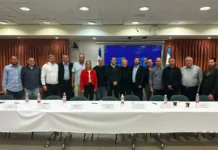This surreal spring season has been all about statistics. While analyzing the rates of infection and fatality, we have also been calculating the risks inherent in numerous daily activities and advising against those that will not advance our communal campaign to “flatten the curve.” On the best days, we’ve tabulated the reports of miraculous recoveries and cautiously planned for life beyond the crisis.
On April 23, as the Israeli government debated how and when it would begin loosening the country’s coronavirus restrictions, ALEH—Israel’s network of care for individuals with severe complex disabilities—received word of a statistic that spoke volumes about the effectiveness of its quarantining methodology and provided renewed hope for the future containment of the novel virus.
After proactively administering 230 COVID-19 tests to the skeleton crew of dedicated medical professionals at ALEH’s residential and rehabilitative center in Jerusalem, and the immunocompromised residents in their care, all 230 tests came back negative. Even more remarkable was the fact that the facility had remained free of infection since shutting its doors to the public on March 9, in an effort to shield the residents from the looming pandemic.
“It became clear immediately that the coronavirus was unlike anything we had ever seen before; it’s transmitted, its impacts on the body, and the fact that there is no vaccine or established immunity. So our methods for combatting the virus and keeping our residents safe would have to be dynamic,” says Shlomit Grayevsky, director of ALEH Jerusalem and a veteran nurse who previously led intensive-care teams at Hadassah, Bikur Cholim and Shaarei Tzedek hospitals.
“We also had to bear in mind that our defensive measures were only half the story, that the state of the economy, transportation, industry and so many other factors could derail our best laid plans. The key, we realized, would be remaining well-informed, following all regulations, and distancing our residents from everyone and everything that could potentially threaten their health, no matter how heart wrenching such restrictions might become.”
In early March, ALEH’s centers across Israel implemented extreme sterilization protocols to protect their residents with severe complex disabilities, all of whom have compromised immune systems and weak respiratory functioning. From the very beginning, Grayevsky’s nimble and innovative team in Jerusalem has led the charge, establishing best practices for the ALEH network and all facilities caring for vulnerable populations during this ongoing crisis.
Grayevsky explains that the biggest difference between COVID-19 and viruses we have encountered previously is its reach.
“In most cases, when we face an infectious disease, there is an understanding that medical professionals may be putting themselves in harm’s way to heal the patient and contain the infection, but that the battleground is within the hospital,” she says. “We are also usually able to establish a ‘front’ of immunity from which to wage our war. But everything is different with COVID-19, because everyone is susceptible, the war is everywhere, and we are forced to worry about our own safety while trying to protect an incredibly vulnerable population.”
‘I am always preparing for the worst’
For this reason, Grayevsky’s methods take isolation to the next level.
In addition to banning visitors and mandating that head-to-toe protective gear be worn at all times, all nonessential workers were sent home and a strict lockdown was implemented, with many staff members and a handful of select National Service volunteers living at the ALEH center for weeks at a time to limit the risk of contamination that would come from commuting to work. Essential medical personnel who needed to return home to care for their families were provided with a private shuttle to and from their homes (the only permissible destination) and underwent a rigorous physical examination every time they returned to the center.
Additionally, the residents were divided into very small groups, separated by floors and quarantined with their dedicated care givers, effectively keeping residents at a distance from their most beloved staff members and volunteers for the sake of health and safety.
“I am a pessimist by nature, so I am always preparing for the worst,” attests Grayevksy. “Thinking along these lines, we were able to figure out how to best counteract the natural human inclination toward intimacy, even though it flies in the face of ALEH’s attitude towards inclusion. It was a strange exercise, but instead of figuring out how to draw people in, we thought of every possible way to keep infection out.”
“Our most difficult regulation was denying entry to parents, but we had to remain vigilant for the sake of their precious children and our staff. As time went on, the parents began to understand the rationale behind our restrictions and thanked us for being so strict. We were also able to ease the pain of separation by keeping them connected with their children via video conference. Their patience and sacrifice will be rewarded in the end.”
Understanding that even the most stringent preventative measures aren’t airtight, Grayevsky’s team also developed a rotating on-call and reserve system to ensure that there would always be a full team available to care for the residents.
For example, when “Team A” is caring for the residents at the center, the members of “Team B” are instructed to remain self-quarantined at home. If a member of “Team A” should contract the virus, her entire team would leave the center immediately and a smaller transition team on premises would fill in until “Team B” arrives to take their place. This simple but effective method has made all the difference over the last two months, safeguarding the system of specialized care upon which the residents rely.
“Planning ahead and having systems in place was absolutely crucial. We could not have weathered this storm nearly as well without them. But our ability to read situations quickly, adapt appropriately and make sound decisions on the fly was just as important to our success,” says Grayevsky. “From day one, I stressed the centrality of discipline, the importance of checking and rechecking every detail and every decision to make sure that our residents are being provided with the very best care. Again, with a population this vulnerable, there is no room for error.”
Grayevsky stresses that creative thinking and real-time response are only effective when coupled with flawless communication.
“The entire care team—from senior management staff all the way down to the volunteers—must always be on the same wavelength. No matter how skilled they might be, no single member of the team should be left alone to make decisions. Teams must work together as a unit, with constant input from the senior staff.”
Not surprisingly, strong external support also played a huge role in ALEH’s ability to create a “protective cocoon” for the residents. Grayevsky notes that her team was able to operate with an elevated level of confidence knowing that their “essential hardware” was being generously funded by friends of ALEH around the globe. She is also indebted to those who helped endow the private shuttles and kept the center stocked with life-saving daily respiratory treatments.
But Grayevsky makes it clear that she is most grateful to the One Above.
“Day after day, I am reminded that God is guiding our hands, watching over us and keeping us safe. After spending decades caring for individuals with disabilities, I am thankful for even the smallest successes, and I don’t take anything for granted. I never allow myself to get too comfortable, and always remain alert.”
Looking ahead, she expresses deep concern regarding a possible second wave of infection and urges the public to embrace real societal change for the sake of our shared world. “While I know that this crisis was a wakeup call for many, there is still so much to be done. The only way to ensure that we don’t trigger another, much worse cycle of infection is the advancement of a collective shift towards mindfulness.”
“Real change can only occur in a world that is more conscious and less complacent,” asserts Grayevsky. “May it happen speedily in our days.”


























